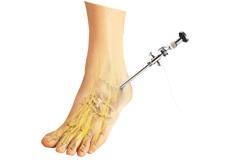Ankle Arthroscopy

What is Ankle Arthroscopy?
Ankle arthroscopy is a minimally invasive surgical procedure in which an arthroscope, a small, soft, flexible tube with a light and video camera at the end, is inserted into the ankle joint to evaluate and treat a variety of conditions.
An arthroscope is a small, fiber-optic instrument consisting of a lens, light source, and video camera. The camera projects an image of the inside of the joint onto a large screen monitor allowing the surgeon to look for any damage, assess the type of injury, and repair the problem.
What are the Indications for Ankle Arthroscopy?
Ankle Arthroscopy, also referred to as keyhole surgery or minimally invasive surgery, has proven to be highly effective in managing various ankle disorders including ankle arthritis, ankle instability, ankle fracture, osteochondral defects of the talus, infection, and undiagnosed ankle pain.
What are the Benefits of Ankle Arthroscopy?
The benefits of arthroscopy compared to the alternative, open ankle surgery, include:
- Smaller incisions
- Minimal soft tissue trauma
- Less pain
- Faster healing time
- Lower infection rate
- Less scarring
- Earlier mobilization
- Shorter hospital stay
How is an Ankle Arthroscopy Procedure Performed?
Your surgeon will make 2 or 3 small incisions around the ankle joint. Through one of the incisions an arthroscope is inserted. Along with it, a sterile solution is pumped into the joint to expand the joint area and create room for the surgeon to work.
The larger image displayed on the television monitor allows the surgeon to visualize the joint directly to determine the extent of damage so that it can be surgically treated. Surgical instruments will be inserted through the other tiny incisions to treat the problem.
After the surgery, the instruments are removed, and the incisions are closed and covered with a bandage.
What is the Post-surgical care for Ankle Arthroscopy?
After the procedure, you will be taken to a recovery room. The ankle joint will be immobilized with a splint or cast. The nature and duration of immobilization will depend on the type of repair performed and the preference of the surgeon. The surgical site should be kept clean and dry during the healing process. Patients may be prescribed pain medication for the management of pain. Elevation of the ankle and ice application helps to reduce pain and swelling. Follow your post-operative instructions for the best outcome.
What are the Risks and Complications of Ankle Arthroscopy?
Ankle arthroscopy is a safe procedure and the incidence of complications is low. However, as with any surgery, risks and complications can occur. Some associated risks with ankle surgery can include infection, damage to blood vessels or nerves, bleeding, and compartment syndrome.

